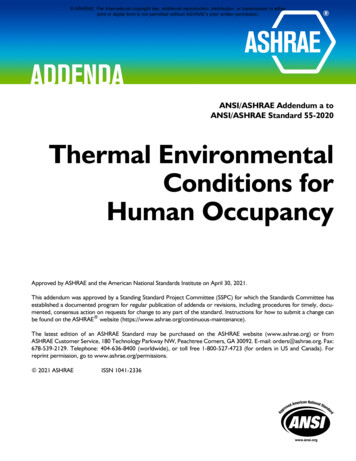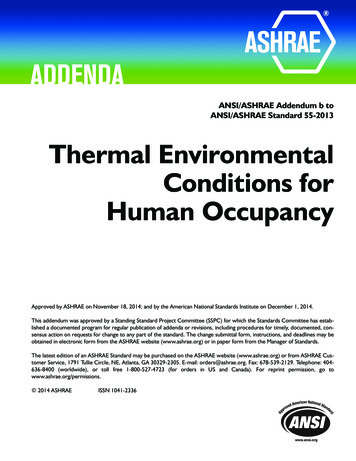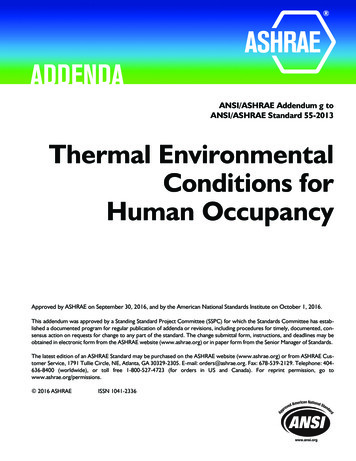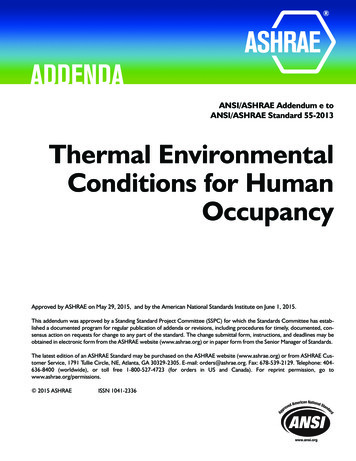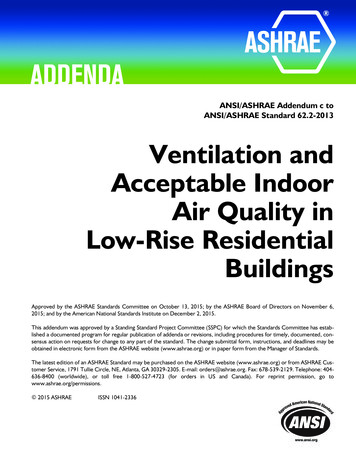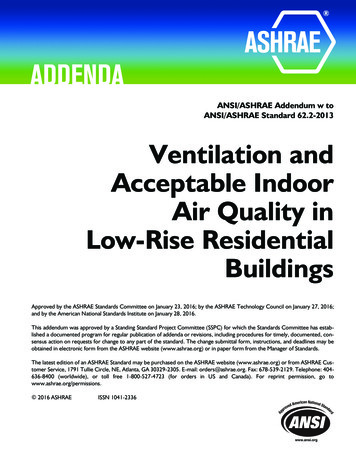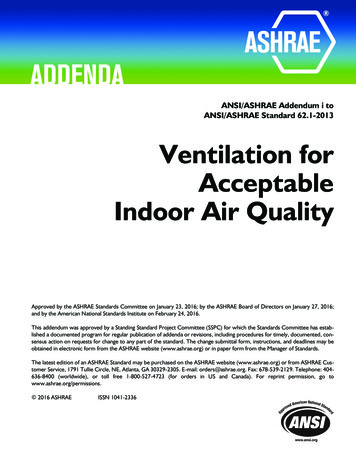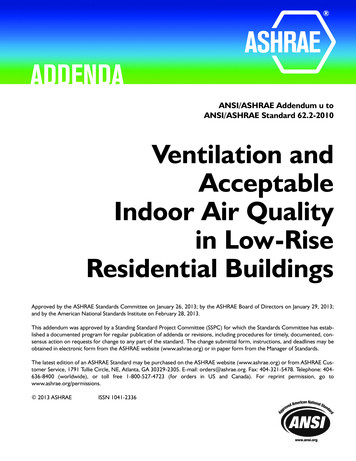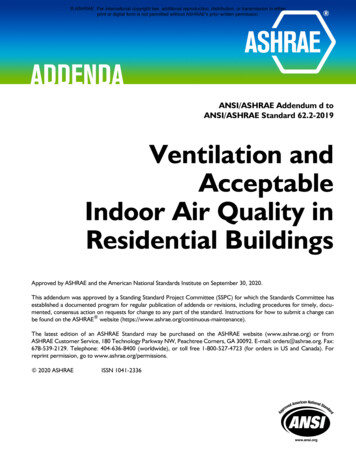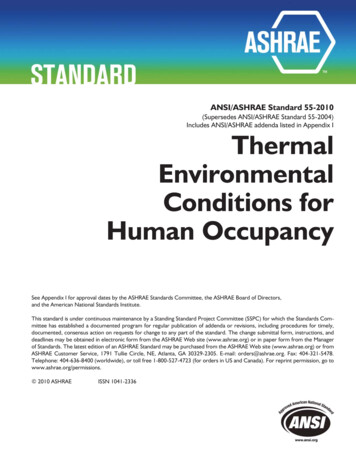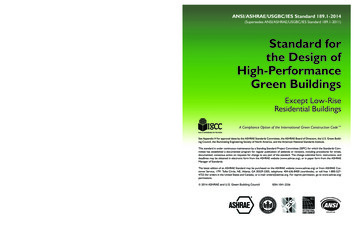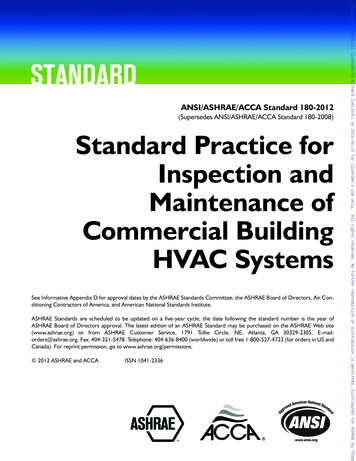
Transcription
(Supersedes ANSI/ASHRAE/ACCA Standard 180-2008)See Informative Appendix D for approval dates by the ASHRAE Standards Committee, the ASHRAE Board of Directors, Air Conditioning Contractors of America, and American National Standards Institute.ASHRAE Standards are scheduled to be updated on a five-year cycle; the date following the standard number is the year ofASHRAE Board of Directors approval. The latest edition of an ASHRAE Standard may be purchased on the ASHRAE Web site(www.ashrae.org) or from ASHRAE Customer Service, 1791 Tullie Circle, NE, Atlanta, GA 30329-2305. E-mail:orders@ashrae.org. Fax: 404-321-5478. Telephone: 404-636-8400 (worldwide) or toll free 1-800-527-4723 (for orders in US andCanada). For reprint permission, go to www.ashrae.org/permissions. 2012 ASHRAE and ACCAISSN 1041-2336All rights reserved. No further reproduction or distribution is permitted. Distributed for ASHRAE by ThomsStandard Practice forInspection andMaintenance ofCommercial BuildingHVAC SystemsCopyrighted material licensed to Richard Zielinski on 2016-06-15 for licensee's use only.ANSI/ASHRAE/ACCA Standard 180-2012
ASHRAE Standing Standard Project Committee 180Cognizant TCs: Lead Cognizant TC 7.3, Operation and Maintenance Management;Co-Cognizant TC 2.4, Particulate Air Contaminants and Particulate Contamination Removal Equipment;and Co-Cognizant TC 9.8, Large Buildings Air-Conditioning ApplicationsASHRAE Staff Liaison: Mark J. WeberSPLS Liaison (2008–2011): Allan B. FraserSPLS Liaison (2011–2012): Rita M. HarroldCharles Eugene Dale-Derks, ChairRichard Alan Danks, Chair (2010–2011)Robert G. Baker, Chair (2008–2010)Mark M. AndersonRobert E. AxelrodWilliam Michael DillardCecily M. GrzywaczEllis G. Guiles, Jr.Glenn C. HourahanJennifer A. IsenbeckS. Louis KelterCarl N. LawsonAngela M. LewisDavid W. LinvilleMichael F. MamayekPhil MaybeeSiroos MostaghimiMarc NewmanStephen W. NicholasThomas L. PaxsonRobert J. RothBoggarm S. SettyCharles J. SeyfferElia M. SterlingKong Sang TsoThomas J. YacobellisASHRAE STANDARDS COMMITTEE 2011–2012Carol E. Marriott, ChairKrishnan GowriMaureen GrassoCecily M. GrzywaczRichard L. HallRita M. HarroldAdam W. HingeDebra H. KennoyJay A. KohlerDouglas T. ReindlBoggarm S. SettyJames R. TaubyJames K. VallortWilliam F. WalterMichael W. WoodfordCraig P. WrayEckhard A. Groll, BOD ExORoss D. Montgomery, COStephanie C. Reiniche, Manager of StandardsSPECIAL NOTEThis American National Standard (ANS) is a national voluntary consensus standard developed under the auspices of ASHRAE.Consensus is defined by the American National Standards Institute (ANSI), of which ASHRAE is a member and which has approved thisstandard as an ANS, as “substantial agreement reached by directly and materially affected interest categories. This signifies the concurrenceof more than a simple majority, but not necessarily unanimity. Consensus requires that all views and objections be considered, and that aneffort be made toward their resolution.” Compliance with this standard is voluntary until and unless a legal jurisdiction makes compliancemandatory through legislation.ASHRAE obtains consensus through participation of its national and international members, associated societies, and public review.ASHRAE Standards are prepared by a Project Committee appointed specifically for the purpose of writing the Standard. The ProjectCommittee Chair and Vice-Chair must be members of ASHRAE; while other committee members may or may not be ASHRAE members, allmust be technically qualified in the subject area of the Standard. Every effort is made to balance the concerned interests on all ProjectCommittees.The Manager of Standards of ASHRAE should be contacted for:a. interpretation of the contents of this Standard,b. participation in the next review of the Standard,c. offering constructive criticism for improving the Standard, ord. permission to reprint portions of the Standard.DISCLAIMERASHRAE uses its best efforts to promulgate Standards and Guidelines for the benefit of the public in light of available information andaccepted industry practices. However, ASHRAE does not guarantee, certify, or assure the safety or performance of any products, components,or systems tested, installed, or operated in accordance with ASHRAE’s Standards or Guidelines or that any tests conducted under itsStandards or Guidelines will be nonhazardous or free from risk.ASHRAE INDUSTRIAL ADVERTISING POLICY ON STANDARDSASHRAE Standards and Guidelines are established to assist industry and the public by offering a uniform method of testing for ratingpurposes, by suggesting safe practices in designing and installing equipment, by providing proper definitions of this equipment, and by providingother information that may serve to guide the industry. The creation of ASHRAE Standards and Guidelines is determined by the need for them,and conformance to them is completely voluntary.In referring to this Standard or Guideline and in marking of equipment and in advertising, no claim shall be made, either stated or implied,that the product has been approved by ASHRAE.All rights reserved. No further reproduction or distribution is permitted. Distributed for ASHRAE by ThomsKenneth W. Cooper, Vice-ChairDouglass S. AbramsonKarim AmraneCharles S. BarnabyHoy R. Bohanon, Jr.Steven F. BruningDavid R. ConoverSteven J. EmmerichAllan B. FraserJanice C. PetersonCopyrighted material licensed to Richard Zielinski on 2016-06-15 for licensee's use only. ASHRAE and ACCA (www.ashrae.org, www.acca.org). For personal use only. Additional reproduction, distribution,or transmission in either print or digital form is not permitted without ASHRAE's prior written permission.
CONTENTSANSI/ASHRAE/ACCA Standard 180-2012,Standard Practice for Inspection and Maintenanceof Commercial Building HVAC SystemsSECTIONPAGENOTEApproved addenda, errata, or interpretations for this standard can be downloaded free of charge from the ASHRAEWeb site at www.ashrae.org/technology. 2012 ASHRAE and ACCAASHRAEACCA1791 Tullie Circle NE2800 Shirlington Road, Ste. 300Atlanta, GA 30329Arlington, VA 22206www.ashrae.orgwww.acca.orgAll rights reserved.All rights reserved. No further reproduction or distribution is permitted. Distributed for ASHRAE by ThomsForeword . 21 Purpose . 22 Scope . 33 Definitions. 34 Implementation . 35 Required Inspection and Maintenance Tasks . 5Table 5-1 Air Distribution Systems . 6Table 5-2 Air Handlers . 7Table 5-3 Boilers . 8Table 5-4 Chillers—Absorption . 9Table 5-5 Chillers—Air-Cooled. 10Table 5-6 Chillers—Water-Cooled . 11Table 5-7 Coils and Radiators. 12Table 5-8 Condensing Units. 13Table 5-9 Control Systems. 13Table 5-10 Cooling Towers and Evaporative-Cooled Devices . 14Table 5-11 Dehumidification and Humidification Devices . 14Table 5-12 Economizers—Air-Side . 15Table 5-13 Engines, Microturbines. 15Table 5-14 Fans (e.g., Exhaust, Supply, Transfer, Return). 16Table 5-15 Fan-Coils, Hot Water, and Steam Unit Heaters . 17Table 5-16 Furnaces, Combustion Unit Heaters . 18Table 5-17 HVAC Water Distribution Systems. 19Table 5-18 Indoor Section Duct-Free Splits . 20Table 5-19 Outdoor Air Heat Exchanging Systems. 21Table 5-20 PTACs/PTHPs (Package Terminal Air Conditioners or Heat Pumps) . 22Table 5-21 Pumps . 22Table 5-22 Rooftop Units . 23Table 5-23 Steam Distribution Systems . 24Table 5-24 Terminal and Control Boxes (e.g., VAV, Fan-Powered, Bypass). 24Table 5-25 Water-Source Heat Pumps . 25Informative Appendix A—Sources of Performance Objectives . 26Informative Appendix B—Identifying Indicators of Unacceptable Conditions . 26Informative Appendix C—Bibliography . 26Informative Appendix D—Addenda Description Information . 29Copyrighted material licensed to Richard Zielinski on 2016-06-15 for licensee's use only. ASHRAE and ACCA (www.ashrae.org, www.acca.org). For personal use only. Additional reproduction, distribution,or transmission in either print or digital form is not permitted without ASHRAE's prior written permission.
(This foreword is not part of this standard. It is merelyinformative and does not contain requirements necessaryfor conformance to the standard. It has not beenprocessed according to the ANSI requirements for astandard and may contain material that has not beensubject to public review or a consensus process.Unresolved objectors on informative material are notoffered the right to appeal at ASHRAE or ANSI.)FOREWORD2This document describes the minimum acceptable levelof maintenance for commercial building HVAC systems.Other standards or guidance documents may establishmore specific or rigorous requirements that apply to certain buildings. Where applicable, those requirementsshould be followed or considered (if guidelines). This document is not intended to limit the level of service provided orrecommendations made by a service provider. Those delivering HVAC maintenance are encouraged to consider andrecommend energy conservation measures or technologyimprovements that would help maintain or increase thermal comfort, the energy efficiency of the HVAC system, andindoor air quality.Much of the information that will be required to preparethe maintenance program that is mandated by this standardcan most conveniently be obtained from the building commissioning (recommissioning or retrocommissioning) documents. Although recommissioning is not a requirement ofthis standard, it should be considered where the commissioning data is either unavailable or outdated. Additionally,ASHRAE Guideline 4, Preparation of Operating and Maintenance Documentation for Building Systems, and ASHRAEGuideline 32, Sustainable, High-Performance Operationsand Maintenance, may be helpful to practitioners seeking todevelop or expand maintenance programs. ASHRAE continues to provide industry reference documents and is in process of preparing other guidelines on commissioning andtraining. Refer also to this standard’s InformativeAppendix C, Bibliography, which lists many reference documents by ASHRAE and other organizations as well as industry technical papers and publications. Some of thesedocuments include ideas toward “Best Practices” or “Reliability-Centered” or other means and methods above theminimum standard.This standard is written in code-intended language so itmay be referenced or adopted by enforcement authorities asthe minimum acceptable level of performance within theirjurisdictions.Note: This standard is specifically focused on the impactsof maintenance on occupant thermal comfort, energy efficiency, and indoor air quality. Additional maintenanceprogram considerations related to equipment reliabi
ASHRAE Guideline 4, Preparation of Operating and Mainte-nance Documentation for Building Systems, and ASHRAE Guideline 32, Sustainable, High-Performance Operations and Maintenance, may be helpful to practitioners seeking to develop or expand maintenance programs. ASHRAE contin-ues to provide industry reference documents and is in pro- cess of preparing other guidelines on commissioning and .

